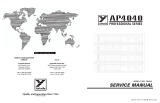Page is loading ...

Le Chat Noir Drive
Simple but effective drive with
great touch response
Contents of this document are ©2023 Pedal Parts Ltd.
No reproduction permitted without the express written
permission of Pedal Parts Ltd. All rights reserved.

Important notes - DO NOT SKIP!
If you’re using any of our footswitch daughterboards,
DOWNLOAD THE DAUGHTERBOARD DOCUMENT
•Download and read the appropriate build document for the daughterboard as well as
this one BEFORE you start the build.
•DO NOT solder the supplied Current Limiting Resistor (CLR) to the main circuit board
even if there is a place for it. This should be soldered to the footswitch daughterboard.
This applies to older PCBs with a pad marked LED next to the IN V G OU pads.
POWER SUPPLY
Unless otherwise stated in this document this circuit is designed to be powered with
9V DC Tip-Negative supply.
COMPONENT SPECS
Unless otherwise stated in this document:
•Resistors should be 0.25W. You can use those with higher ratings but check the
physical size of them. For kits that use 3mm resistors instead of standard 6mm, these
will usually be either 0.125W or 0.4W.
•Electrolytics caps should be at least 25V for 9V circuits, 35V for 18V circuits. Again,
check physical size if using higher ratings.
LAYOUT CONVENTIONS
Unless otherwise stated in this document, the following are used:
Electrolytic capacitors:
Long leg (anode) to square pad. Stripe indicates cathode.
Diodes/LEDs:
Striped leg (cathode) to square pad. Short leg to square pad for LEDs.
The exception to this is with Russian germanium diodes - stripe = anode.
•ICs:
Square pad indicates pin 1.

Schematic + BOM
R1 100K
R2 100K
R3 1M
R4 22K
R5 470K
R6 22K
R7 1M
R8 430R*
C1 10u elec
C2 100n
C3 220p
C4 100n
C5 100u elec
C6 100n
C7 220p
C8 100p
C9 100n
D1 1N5817
IC1 OP275**
GAIN 50KA
VOL 50KA
*Absolutely not critical. Use 100R - 510R.
**The ‘magic’ supposedly comes from the IC, but feel free to
chop and change for other dual op amps. It sounds pretty
sweet with this though, so probably worth the little extra.

PCB layout ©2023 Pedal Parts Ltd.
The power and signal pads on the PCB conform
to the FuzzDog Direct Connection format, so can
be paired with the appropriate daughterboard for
quick and easy offboard wiring. Check the
separate daughterboard document for details.
Be very careful when soldering the diode.
They’re very sensitive to heat. You should use
some kind of heat sink (crocodile clip or reverse
action tweezers) on each leg as you solder them.
Keep exposure to heat to a minimum (under 2
seconds). Same goes for the IC if you aren’t
using a socket.
Snap the small metal tag off the pots so they can
be mounted flush in the box.
You should solder all other board-mounted
components before you solder the pots and
switches. Once they’re in place you’ll have no
access to much of the board. Make sure your
pots all line up nicely.
The best way to do that is to solder
a single pin of each pot in place then melt and
adjust if necessary before soldering in the other
two pins.

Test the board!
Check the relevant daughterboard document for more
info before you undertake this stage.
UNDER NO CIRCUMSTANCES will troubleshooting help
be offered if you have skipped this stage. No exceptions.
Once you’ve finished the circuit it makes sense to test is before starting on the switch and LED
wiring. It’ll cut down troubleshooting time in the long run. If the circuit works at this stage, but it
doesn’t once you wire up the switch - guess what? You’ve probably made a mistake with the switch.
Solder some nice, long lengths of wire to the board connections for 9V, GND, IN and OUT. Connect
IN and OUT to the jacks as shown. Connect all the GNDs together (twist them up and add a small
amount of solder to tack it). Connect the battery + lead to the 9V wire, same method. Plug in. Go!
If you’re using a ribbon cable you can tack the wires to the ends of that. It’s a lot easier to take them
off there than it is do desolder wires from the PCB pads.
If it works, carry on and do your switch wiring. If not... aw man. At least you know the problem is
with the circuit. Find out why, get it working, THEN worry about the switch etc.
Your completed circuit board
including pots

Now’s the time
to refer to the
daughterboard
document for
your chosen
bypass method.
Enjoy your pedal!

This template is a rough guide only. You should ensure correct marking of your
enclosure before drilling. You use this template at your own risk.
Pedal Parts Ltd can accept no responsibility for incorrect drilling of enclosures.
FuzzDog.co.uk
Recommended drill sizes:
Pots 7mm
Jacks 10mm
Footswitch 12mm
DC Socket 12mm
Toggle switches 6mm
32mm
Drilling template
without battery - side DC
Hammond 1590B - 60 x 111 x 31mm
It’s a good idea to drill the pot and
toggle switch holes 1mm bigger if
you’re board-mounting them.
Wiggle room = good!
/














